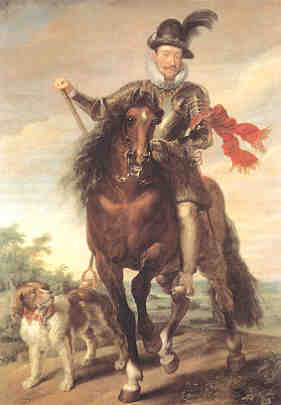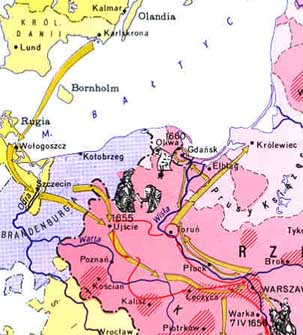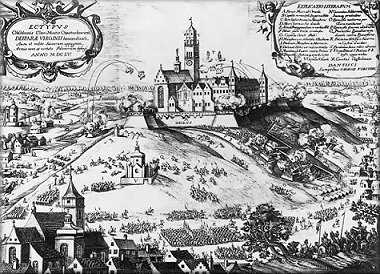
The reign of the Vasa dynasty (1587-1668)
the wars with Sweden and the events of the Swedish Deluge
by Peter K. Gessner
Introduction
| |
| King Sigismund III Vasa |
The supporters of his claim to the Polish throne having won the Royal election in 1587, Sigismund left Sweden to be crowned as Sigismund III, King of Poland. He would have much preferred, however, to be King of Sweden. That opportunity arose upon the death of his father who, following the passing of his royal brother, had been crowned King of Sweden as John II Vasa. In 1592, Sigismund III journeyed to Sweden where, he in turn, was crowned King of Sweden. Before returning to Poland, he appointed his uncle Charles as regent. The Swedes resented, however, his efforts to convert them to Catholicism and in 1599 the Parliament in Stockholm deposed him, crowning his uncle as Charles IX, with the proviso that Sigismund's son Władysław could acceded to the throne if he became Lutheran.
At the time of his election, Sigismund III had agreed in the 'pacta conventa' (the covenant negotiated between the prospective ruler and the ruled) to unite present day Estonia to the Polish Commonwealth - which in those days encompassed present day Latvia - but had failed to do carry out the promise, thinking it could become part of his Swedish kingdom. Now on March 12, 1600, he moved to do so, provoking an armed reaction from Sweden which, following the dethroning, had gained possession of present day Finland. Thus, began the Polish-Swedish wars destined to continue for more that half a century. Sigismund III himself died in 1632 after what historian Adam Zamoyski has termed "the longest and possibly the most incompetent reign in Poland's history." He was succeeded, first by Władysław IV (1632-48), his son by Anne of Habsburg, and then by Jan Kazimerz (1648-68), his son by Constance of Habsburg. The reign of the Vasa dynasty in Poland with the abdication of Jan Kazimierz on September 16, 1668.
The Deluge
 The Lithuanian Prince, Janusz Radziwiłł |
Already in 1648, Poland position was a difficult one, with a revolt brewing in the Ukraine and during the course of it an attack by Russian troops. At the peak of the conflict with Russia, on the 25th of July, 1655, breaking the 1635 truce, Swedish troops crossed Poland's borders.
Two columns of Swedish troops made their way across Poland. The first one, under the command of Marshal Wittenberg, marched in the direction of Greater Poland, where on the 25th of July, 1655, the Polish nobles and magnates placed themselves under Swedish protection without a fight. The second colmn under the command of Pontus de la Gardie, occupied Lithuania, where also without a fight, on the 8th of September, the Lithuanian Prince, Janusz Radziwiłł, Grand Hetman of Lithuania, i.e. the Commander in Chief of the Polish forces in Lithuania, broke the Union with Poland and surrenderead the suzerainty of Lithuania to Carl Gustav, the Swedish King. The nobility of sequentially occupied lands also recognized the suzerinty of Carl Gustav, and even the Royal Polish troops of Hetman Koniecpolski followed suit. In September, again without a fight, Warsaw found itself in Swedish hands, and in October Krakow, defended by Czarniecki fell. The will to fight was absent among the nobility and this in great part decided the initial success of Carl Gustav's strategy.
| |
| For enlargement click on map |
From November 19 till December 25, 1655, the monastery of Pauline Fathers on Jasna Gora resisted a Swedish siege. News of the impudent attack of the Swedes on the monastery had an electrifyng effect. The invader respected neither his own promises, nor Polish religious feelings; a national uprising ensued. In Tyszowace a confederation of Polish Hetmans - Mikołaj Potocki and Stanislaw Lanckoronski with the Lithuanians of the Governor of Witebsk, Pawe?Sapiecha - came into being. The Uprising enveloped Greater and Lesser Poland as well as Podlasie.
|
|
At the beginning of 1657, the troops of the Principality of Siedmiogrod led by Jerzy Rakoczy entered Poland, burning and destroying. The Royal Army did not, however fall apart and it forced Rakoczy to capitulate in Podole in July 1657. The Swedes had to withdraw from Krakow. On December 23, 1658, after a three month siege, the Poles regained Toru? By the begging of 1660 only Ebląg and Malbork remained in Swedish hands. Thanks to the diplomatic mediation of France, a peace was signed in 1660 in Oliwa on May 3rd, on the basis of which Sweden and Poland returned to their pre-war frontiers. Poland retained Kurlandia and Livonia, while Jan Kazimierz gave up his claims to the Swedish throne.
Nobel prizewinner Henryk Sienkiewicz's epic historical novel The Deluge is a romantic charterization of the events. Potop, a screen version of it was filmed in 1974
Part of the material on this page is based on an English translation of a Polish language web page.
The information in this database may include copyrighted material, and is to be used for educational and research purposes only.


